|
SD45
The SD45 is a six-axle diesel-electric locomotive class built by General Motors Electro-Motive Division between 1965 and 1971. It has an EMD 645E3 twenty-cylinder engine generating on the same frame as the SD38, SD39, SD40, and SDP40. As of 2023, most SD45s have been retired, scrapped or rebuilt to SD40-2 standards. Design A total of 1,260 were built for American railroads before the SD45-2 replaced it in 1972, along with the related SD45T-2 'Tunnel Motor'. SD45s had several teething problems. Reliability was not as high as anticipated; the twenty-cylinder prime mover was prone to crankshaft failure from engine block flex. Though it produced more than the 16-645E3 in the SD40, some railroads felt the extra horsepower was not worth it, even after EMD strengthened the block to eliminate crankshaft failures. At low speeds when tractive effort was adhesion-limited, the SD45 provided no advantage over the SD40. Buyers included the Burlington Northern, Southern Pacific, San ... [...More Info...] [...Related Items...] OR: [Wikipedia] [Google] [Baidu] |
EMD SD45T-2
The SD45T-2 is a model of diesel-electric locomotive built by EMD for the Southern Pacific Railroad. Like the later SD40T-2 it is colloquially nicknamed a tunnel motor. 247 total units (including the original EMD/SP joint-venture prototype) were produced from February 1972 to June 1975, including 84 for SP's subsidiary Cotton Belt. From April 1986 to December 1989, 126 were rebuilt and re-designated as ''SD45T-2R'', including 24 for Cotton Belt. The SD45T-2 is a variant of the venerable SD45 that featured the "Dash 2" upgrade components such as improved electronics and high traction trucks, with the "T" denoting its cooling system modifications. The intake for radiator cooling air was moved to the walkway level and the cooling fans themselves were under the radiator cores, instead of above. Tunnel motors were built for mountainous areas in the western United States, where SP had previously encountered repeated overheating issues on their SD45s. The later SD40T-2 looks similar ... [...More Info...] [...Related Items...] OR: [Wikipedia] [Google] [Baidu] |
EMD SD45-2
The EMD SD45-2 is a 6-axle diesel-electric locomotive built by General Motors Electro-Motive Division (EMD). EMD built 136 locomotives between 1972 and 1974, primarily for the Atchison, Topeka and Santa Fe Railway (ATSF). The SD45-2 was an improved version of the EMD SD45; the primary visual difference is the absence of flared radiators on the SD45-2. Design Part of the EMD Dash 2 line, the SD45-2 was an upgraded SD45. Like the SD45, the SD45-2 had an EMD 645E3 20-cylinder engine producing . The main spotting difference between an SD45 and an SD45-2 was the long hood and the rear radiator. On the SD45 the long hood is flared whereas on the SD45-2 it is vertical and the rear cooling fans are more spread out on the top of the rear of the long hood. This unit used the same frame as the EMD SD40-2 and EMD SD38-2. The largest owner of the SD45-2 was the Atchison, Topeka, & Santa Fe with 90 units, the Clinchfield had 18 units, Seaboard Coast Line had 15 units and Erie Lackawann ... [...More Info...] [...Related Items...] OR: [Wikipedia] [Google] [Baidu] |
EMD SD40-2
The EMD SD40-2 is a AAR wheel arrangement#C-C, C-C diesel–electric locomotive built by Electro-Motive Diesel, EMD from 1972 to 1989. The SD40-2 was introduced in January 1972 as part of EMD's ''EMD Dash 2, Dash 2'' series, competing against the GE U30C. Although higher-horsepower locomotives were available, including EMD's own EMD SD45-2, SD45-2, the reliability and versatility of the SD40-2 made it one of the best-selling models in EMD's history, edged out only by the EMD GP9, GP9, and was the standard of the industry for several decades after its introduction. The SD40-2 was an improvement over the EMD SD40, SD40, with modular electronic control systems similar to those of the experimental DDA40X. Peak production of the SD40-2 was in the mid-1970s. Sales of the SD40-2 began to diminish after 1981 due to the oil crisis, increased competition from GE Dash 7 Series, GE's Dash-7 series and the introduction of the EMD SD50, which was available concurrently to late SD40-2 product ... [...More Info...] [...Related Items...] OR: [Wikipedia] [Google] [Baidu] |
Great Northern 400
Great Northern 400, nicknamed Hustle Muscle, is a restored SD45 diesel locomotive originally owned by the Great Northern (GN). It was built in 1966 as the first production SD45 by Electro-Motive Division. History GN 400 was the first of eight SD45s (400-407) delivered to the Great Northern in May and June 1966. Great Northern was the first railroad company to purchase this model of locomotive. GN 400 was the fourth SD45 built by EMD after the first three demonstrators. Great Northern christened it with its nickname, "Hustle Muscle." All eight SD45s wore Great Northern's simplified orange and green paint scheme, but only 400 wore a nickname. In total, Great Northern owned 27 SD45s built from 1966 through 1968. In 1970, the GN became part of the Burlington Northern (BN). The locomotive was renumbered to 6430, but through 1972 it still wore its GN paint, with the GN logos removed. In 1973, the locomotive underwent a massive "class-one overhaul", and was painted into BN's cascade g ... [...More Info...] [...Related Items...] OR: [Wikipedia] [Google] [Baidu] |
EMD 645
The EMD 645 is a family of two-stroke diesel engines that was designed and manufactured by the Electro-Motive Division of General Motors. While the 645 series was intended primarily for locomotive, marine and stationary engine use, one 16-cylinder version powered the 33-19 "Titan" prototype haul truck designed by GM's Terex division The 645 series was an evolution of the earlier 567 series and a precursor to the later 710 series. First introduced in 1965, the EMD 645 series remained in production on a by-request basis long after it was replaced by the 710, and most 645 service parts are still in production. The EMD 645 engine series is currently supported by Electro-Motive Diesel, Inc., which purchased the assets of the Electro-Motive Division from General Motors in 2005. EMD is currently owned by Progress Rail (since 2010). In 1951, E. W. Kettering wrote a paper for the ASME entitled, ''History and Development of the 567 Series General Motors Locomotive Engine'', which ... [...More Info...] [...Related Items...] OR: [Wikipedia] [Google] [Baidu] |
EMD 645E3
The EMD 645 is a family of two-stroke diesel engines that was designed and manufactured by the Electro-Motive Division of General Motors. While the 645 series was intended primarily for locomotive, marine and stationary engine use, one 16-cylinder version powered the 33-19 "Titan" prototype haul truck designed by GM's Terex division The 645 series was an evolution of the earlier 567 series and a precursor to the later 710 series. First introduced in 1965, the EMD 645 series remained in production on a by-request basis long after it was replaced by the 710, and most 645 service parts are still in production. The EMD 645 engine series is currently supported by Electro-Motive Diesel, Inc., which purchased the assets of the Electro-Motive Division from General Motors in 2005. EMD is currently owned by Progress Rail (since 2010). In 1951, E. W. Kettering wrote a paper for the ASME entitled, ''History and Development of the 567 Series General Motors Locomotive Engine'', which goes ... [...More Info...] [...Related Items...] OR: [Wikipedia] [Google] [Baidu] |
EMD SD40
The EMD SD40 is a model of 6-axle diesel-electric locomotive built by Electro-Motive Diesel, General Motors Electro-Motive Division between January 1966 and August 1972. 1,268 locomotives were built between 1966 and 1972. In 1972, an improved version with new electronics was developed and marketed as a new locomotive, the EMD SD40-2, SD40-2. Design Like its predecessor in EMD's catalog, the EMD SD35, SD35, the SD40 is a high-horsepower, six-axle freight locomotive. The SD40 is a member of EMD's long-running Special Duty class of locomotives, which all are built with 6 axles. In 1966, Electro-Motive Diesel, EMD updated its locomotive catalog with entirely new models, all powered by the new EMD 645, 645 diesel engine. These included six-axle models EMD SD38, SD38, SD40, EMD SDP40, SDP40 and EMD SD45, SD45. All shared standardized components, including the frame, cab (locomotive), cab, Electric generator, generator, Bogie, trucks, traction motors, and Railway air brake, air brakes. ... [...More Info...] [...Related Items...] OR: [Wikipedia] [Google] [Baidu] |
Pennsylvania Railroad
The Pennsylvania Railroad ( reporting mark PRR), legal name as the Pennsylvania Railroad Company, also known as the "Pennsy," was an American Class I railroad that was established in 1846 and headquartered in Philadelphia, Pennsylvania. At its peak in 1882, the Pennsylvania Railroad was the largest railroad (by traffic and revenue), the largest transportation enterprise, and the largest corporation in the world. Over its existence, Pennsylvania Railroad acquired, merged with, or owned part of at least 800 other rail lines and companies. At the end of 1926, it operated of rail line;This mileage includes companies independently operated. PRR miles of all tracks, which includes first (or main), second, third, fourth, and sidings, totalled 28,040.49 at the end of 1926. in the 1920s, it carried nearly three times the traffic as other railroads of comparable length, such as the Union Pacific and Atchison, Topeka & Santa Fe railroads. Its only formidable rival was the New York Centra ... [...More Info...] [...Related Items...] OR: [Wikipedia] [Google] [Baidu] |
Southern Pacific Railroad
The Southern Pacific (or Espee from the railroad initials) was an American Railroad classes#Class I, Class I Rail transport, railroad network that existed from 1865 to 1996 and operated largely in the Western United States. The system was operated by various companies under the names Southern Pacific Railroad, Southern Pacific Company and Southern Pacific Transportation Company. The original Southern Pacific began in 1865 as a land holding company. The last incarnation of the Southern Pacific, the Southern Pacific Transportation Company, was founded in 1969 and assumed control of the Southern Pacific system. The Southern Pacific Transportation Company was acquired in 1996 by the Union Pacific Corporation and merged with their Union Pacific Railroad. The Southern Pacific legacy founded hospitals in San Francisco, Tucson, Arizona, Tucson, and Houston. In the 1970s, it also founded a telecommunications network with a state-of-the-art microwave and fiber optic backbone. This telec ... [...More Info...] [...Related Items...] OR: [Wikipedia] [Google] [Baidu] |
San Bernardino Train Disaster
The San Bernardino train disaster (sometimes known as the Duffy Street incident or the 1989 Cajon Pass Runaway), was a combination of two separate but related incidents that occurred in San Bernardino, California, United States: a runaway train derailment on May 12, 1989; and the subsequent failure on May 25, 1989, of the Calnev Pipeline, a petroleum pipeline adjacent to the tracks which was damaged by earth-moving equipment during the crash cleanup. Train derailment On May 12, 1989, at 7:36 a.m., a 6-locomotive/69-car Southern Pacific Railroad, Southern Pacific freight train (SP 7551 East, computer symbol 1 MJLBP-11) transporting trona lost control while descending Cajon Pass, derailed on an elevated curve and plowed into a residential area on Duffy Street. The location is just northeast of where the Interstate 210 and State Route 210 (California), 210 Foothill Freeway crosses the Lytle Creek wash. The conductor, head-end brakeman, and two residents were killed in the ... [...More Info...] [...Related Items...] OR: [Wikipedia] [Google] [Baidu] |
Atchison, Topeka And Santa Fe Railway
The Atchison, Topeka and Santa Fe Railway , often referred to as the Santa Fe or AT&SF, was one of the largest Class 1 railroads in the United States between 1859 and 1996. The Santa Fe was a pioneer in intermodal freight transport; at various times, it operated an airline, the short-lived Santa Fe Skyway, and the Santa Fe Railroad tugboats. Its bus line extended passenger transportation to areas not accessible by rail, and ferryboats on the San Francisco Bay allowed travelers to complete their westward journeys to the Pacific Ocean. The AT&SF was the subject of a popular song, Harry Warren and Johnny Mercer's " On the Atchison, Topeka and the Santa Fe", written for the film '' The Harvey Girls'' (1946). The railroad officially ceased independent operations on December 31, 1996, when it merged with the Burlington Northern Railroad to form the Burlington Northern and Santa Fe Railway. History Atchison, Topeka & Santa Fe Railway The railroad was chartered in February 1859 ... [...More Info...] [...Related Items...] OR: [Wikipedia] [Google] [Baidu] |
EMD SD39
The SD39 is a model of 6-axle diesel-electric locomotive built by General Motors Electro-Motive Division between August 1968 and May 1970. 54 were built for American railroads. In 1966, EMD replaced all their old models with new ones having the new 645 diesel. These included six-axle models SD38, SD40, SDP40 and SD45; the SD39 was added in 1968. All shared standard components including the frame, cab, traction alternator, trucks, traction motors, and air brakes. The difference was the power output: SD38 = from a non-turbocharged V16, SD39 = from a turbocharged V12, SD40 = from a turbocharged V16, and SD45 = from a turbocharged V20. The SD39 had the smallest prime mover and therefore had the most unused space above the frame, inside the hood between the main generator and electrical cabinet, and outside in large end "porches". Variant A variant was the SDL39, ordered by the Milwaukee Road The Chicago, Milwaukee, St. Paul and Pacific Railroad (CMStP&P), bet ... [...More Info...] [...Related Items...] OR: [Wikipedia] [Google] [Baidu] |









